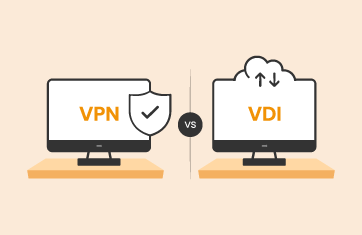Virtual Desktop Infrastructure (VDI) has been a hot topic for years – and every year one expert or another makes a claim that this will be the year of VDI. Finally, VDI goes mainstream. We’re seeing the cost of VDI implementation come down to being roughly comparable to the cost of managing PC endpoints. Many organizations are starting to move from pilot to production. While the pilots worked fine, many organizations are finding that VDI projects fail in the rollout phase due to performance and poor user experience issues. One of the key reasons for this is that the pilot phase is often over-provisioned and less complex.
Don’t miss the infrastructure demands by focusing too much on the desktop
Very often, when an enterprise begins the virtual desktop journey, the focus is on the user desktop. This is only natural; after all, it is the desktop that is moving ‒ from being on a physical system to a virtual machine. Therefore, once a decision to try VDI is made, the primary focus is often to benchmark the performance of physical desktops, model usage, predict the virtualized user experience and, based on the results, determine which desktops can be virtualized and which can’t.
With VDI, the virtual desktops no longer have dedicated resources. The virtual desktops share the CPU, memory, disk and network resources of the physical machine on which they are hosted. While resource sharing provides several benefits, it also introduces new complications in the infrastructure. A single malfunctioning desktop can drain resources to the point that it impacts the performance of all the other desktops.
Resource sharing across virtual desktops also introduces other interesting artifacts. In many of the early VDI deployments, administrators found that when they just migrated physical desktops to VDI, backups or antivirus software could cause problems. These software components were scheduled to run at the same time on all the desktops. When the desktops were physical, it didn’t matter, because each desktop had dedicated hardware. With VDI, the synchronized demand for resources from all the desktops severely impacted the performance of all the virtual desktops. This was not something that was anticipated because the focus of most designs and plans was on individual desktops and not the holistic virtual desktop infrastructure.
The cost of failure with VDI is much higher than with physical desktops
In the physical world if a desktop failed, only one user would be impacted – so the failure or slowdown was minimal. In the virtual world, a single malfunctioning desktop is much more severe, as one failure can impact hundreds of desktops. A CTO of a large multi-national organization recently mentioned this as the single biggest reason why he was averse to moving to virtual desktop technology.
eG Enterprise is an Observability solution for Modern IT. Monitor digital workspaces,
web applications, SaaS services, cloud and containers from a single pane of glass.




